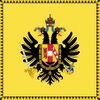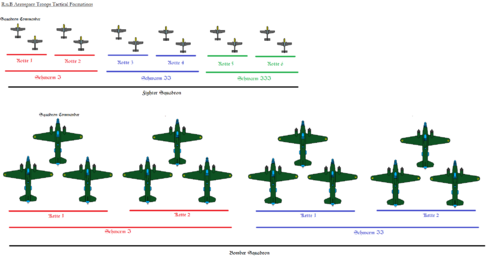Imperial & Federal Aerospace Troops
| R.u.B Luft und Raumfahrt Truppen | |
|---|---|
| Country | |
| Branch | Aerospace |
| Type | Aerospace |
| Role | Aerospace Combat Operations |
| Motto(s) | "Omnes Qui Sub Celo" |
| March | March of the Stars |
| Commanders | |
| Commander-in-Chief | Emperor Karl Fraz II |
| Minister for Aerospace Troops | Minister Imai Toshinao |
| Chief of the Aerospace Staff | Chief Marshal Hector Rampton |
| Insignia | |
| Imperial Standard | |
The Imperial & Federal Aerospace Troops (R.u.B Luft-und-Raumfahrt Truppen) consists of the aerospace forces controlled by the Imperial and Federal Union, with the primary intention of providing strategic power projection into hostile territory, as well as defending the R.u.B Union against similar projection of power on the tactical, operational, and strategic scales. The Aerospace Troops are the smallest of the three branches that make up the Kaiserliche Wehrmacht, and is usually considered the junior-most of the three branches. However, the Aerospace Troops are generally seen as 'punching above their weight', given their ability to project power in a surgical manner. The Aerospace Troops are deployed throughout the R.u.B Union, both in forward bases meant for projection of power, and bases near key targets within the R.u.B Union. The Aerospace Troops are also responsible for almost all atmospheric warfare, outside of the Navy's area of responsibility.
History
Structure
Aerospace Ministry
Aerospace General Staff
Combat Commands
There are three Combat Commands within the R.u.B Aerospace Troops: Fighter Command, Tactical Command, Bomber Command, Patrol Command, Support Command and Defence Command. Despite the name, the Combat Commands are not responsible for actual coordination of combat operations, and do not directly control any element of the R.u.B Aerospace Troops. Rather, the Combat Commands are sub-divisions of the R.u.B Air Ministry responsible for supporting their associated mission profiles. Each Combat Command is responsible for training, maintenance, repair, and logistics of its associated combat elements. The Combat Commands are also responsible as the interface between the actual combatants of the Aerospace Troops and the government bodies responsible for supervising them.
The Combat Commands hold primary responsibility for issuing requirements for new strike craft and other forms of equipment for the Aerospace Troops, as well as reviewing the various design proposals received. Once designs have been formalised, the Combat Commands are responsible for organising the production of new equipment, awarding contracts, as well as delivering the equipment to frontline units.
Operational and Tactical Organisation
Aerospace Fleets
The Aerospace Fleet (Luftflotte) is the largest form of operational organisation for the R.u.B Aerospace Troops, and is the equivalent of either a Navy Fleet Group, or Common Army Field Army. All strike craft and other units of the Aerospace Troops belong to an Aerospace Fleet, which exist independently of their subordinate units. The primary role of an Aerospace Fleet is to provide necessary logistics, maintenance, administration, and other forms of support for attached units, freeing combat units of the need to have extensive organic support elements. Aerospace Fleets are generally assigned to a fixed astrographic location, and hold ultimate responsibility for all units in that area. Aerospace Fleets are formed and disbanded as necessary, as astrographic regions within the R.u.B Aeropsace Troop's jurisdiction change. An Aerospace Fleet can vary dramatically in size and capabilities, as various tactical units are attached or re-assigned, depending on the needs of the fleet in question, or the availability of units.
Depending on scale, an Aerospace Fleet may be sub-divided into Aerospace Corps, which may be necessary for certain high activity Aerospace Fleets, where central control of all operations is not possible. An Aerospace Corps is similar to a Fleet in almost every respect, just on a smaller scale. In addition, Aerospace Fleets are the primary high level operational command for the R.u.B Aerospace Troops, developing large scale mission plans and objectives, as well as coordinating with other branches of the R.u.B military to maximise the effectiveness of the Aerospace Troops in combined-arms.
Geschwader
The geschwader, or Wing, is the largest mobile formation of craft within the R.u.B Aerospace Troops. Each geschwader will have a defined purpose, and be fitted into one of the various Combat Commands in terms of whom holds responsibility for that type of unit. A geschwader will usually be named by type, with an abbreviation followed by a number for identification (e.g. Kampfgeschwader III (KG III). Certain units lack a standard numerical identifier, and are instead be known by a name (e.g. Jagdgeschwader Garde; en. Imperial Guard Fighters). Such names are usually given as a special recognition of the unit's combat effectiveness or bravery, and as such, named geschwader are usually considered to be elite units.
| Purpose | Name | Abbreviation | Combat Command |
|---|---|---|---|
| Fighter | Jagdgeschwader | JG | Fighter Command |
| Heavy Fighter | Zerstoerergeschwader | ZG | Fighter Command |
| Close Support | Schlachtgeschwader | SG | Tactical Command |
| Tactical and Operations Bomber | Schnellkampfgeschwader | SKG | Tactical Command |
| Strategic Bomber | Kampfgeschwader | KG | Bomber Command |
| Patrol Bomber | Erkundenkampfgeschwader | EKG | Patrol Command |
| Reconnaissance | Aufklärungsgeschwader | AG | Patrol Command |
| Transport | Transportgeschwader | TG | Support Command |
Each geschwader will normally contain three to four groups of strike craft, along with a Staff Flight, of two to four craft, depending on the geschwader's type. Jagdgeschwader, Schlachtgeschwader, and Schnellgeschwader all usually contain four groups, with a four craft staff flight, while all other forms of unit maintain a three group, two craft staff flight structure. An exception to this is the Schnellgeschwader, which can vary in size, depending on whether they are equipped with strike or medium bombers.
Tactical Organisation
Each geschwader is broken up into three or four Gruppes (Groups). Each gruppe is identified via a Roman numeral in front of its parent geschwader. (e.g. II/JG. 10, the second group of Jagdgeschwader II) As each gruppe will ordinarily have its own base in combat operations, a group will contain an organic support platoon, designed to supplement the administrative, maintenance, and logistics capability of the unit's parent Aerospace Fleet. Each gruppe will normally contain a Command Flight of two to three craft, along with three squadrons of strike craft, giving a gruppe an full strength of thirty-eight to thirty-nine strike craft. Some Jagdgeschwader formations may find their strength expanded to four squadrons per group, bringing their strength up to fifty to fifty-one strike craft. In general, each gruppe is fully equipped with the same model of strike craft, in order to ease the logistical burden of the gruppe's limited organic support unit.
A squadron is the primary tactical combatant formation of the Aerospace Troops. Each squadron will consist of twelve strike craft, regardless of type. Each squadron is identified via Arabic numeral in front of its parent geschwader, in ascending order. (e.g. 2/JG.10, the second squadron in Jagdgeschwader 10.) This numbering system is done independently of the gruppe. (e.g. 1, 2, 3, and 4/JG.10--the first to fourth squadrons of JG.10 will make up I/JG.10, the first gruppe of JG.10) The squadron is the primary unit of tactical combat, and will be assigned specific objectives by their parent geschwader.
The internal organisation of a squadron will vary, depending on whether the squadron is a bomber or fighter squadron. Each squadron is organised into 'schwarms (swarms). A fighter squadron is organised into three schwarms of four fighters each, while a bomber squadron is organised into two schwarms of six bombers each. Internally, each schwarm is divided into sub-units, rottes (packs) for fighters, and kettes (chains) for bombers. A rotte will consist of two fighters, while a kette will contain three bombers. These formations are primary units of aerospace combat, and will generally stay together throughout combat operations.
Aerospace Defence Corps
Administrative Organisation
Tactical and Operational Organisation
Personnel
Recruitment
Ranks
| Officer Ranks | Enlisted Ranks |
|---|---|
| Chief Marshall | |
| Marshal | |
| Vice-Marshal | |
| Commodore | |
| Colonel | |
| Commander | Warrant Officer |
| Major | Technical Sergeant |
| Captain | Flight Sergeant |
| Lieutenant | Sergeant |
| Flying Officer | Senior Flier |
| Pilot Officer | Flight Corporal |
| Cadet | Flier |
Equipment
Fighters
- J.17 Hussar Tactical Fighter
- J.19 Companion Tactical Fighter
- J.21 Uhlan Heavy Fighter
- J.25 Caracole Superiority Fighter
Bombers
- S.11 Peregrine Attack Bomber
- S.19 Leopard Strike Bomber
- K.5 Barracuda Medium Bomber
- K.11 Griffon Heavy Bomber
- K.15 Manticore Heavy Bomber

